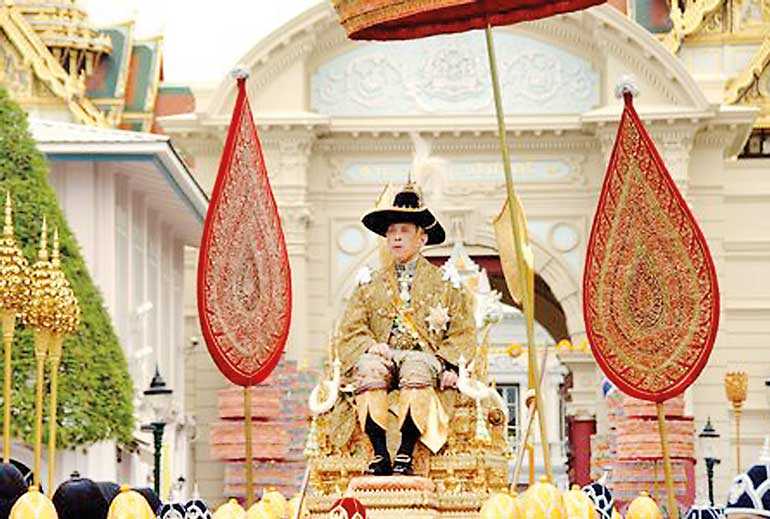Thursday Jan 16, 2025
Thursday Jan 16, 2025
Monday, 6 May 2019 00:00 - - {{hitsCtrl.values.hits}}

BANGKOK (Reuters): Thailand’s King Maha Vajiralongkorn on Saturday completed intricate Buddhist and Brahmin rituals to symbolically transform him into a living god as the Southeast Asian nation officially crowned its first monarch in nearly seven decades.
King Vajiralongkorn, 66, became constitutional monarch after the death of his revered father, King Bhumibol Adulyadej, in October 2016 after 70 years on the throne.
The king was joined by new Queen Suthida after a surprise announcement three days before the coronation that the thrice-divorced monarch had married for a fourth time.
His coronation, after a period of mourning for the late king, comes amid the uncertainty of an unresolved election battle between the current military junta chief and a “democratic front” trying to push the army out of politics.
King Vajiralongkorn sat erect on a high throne above his queen, royal family members and Brahmin priests inside the Grand Palace throne hall where the royal guardian deity Phra Siam Devadhiraj is said to reside.
“I shall reign in righteousness for the benefits of the kingdom and the people forever,” the king said in his first royal command, while sitting under a nine-tiered umbrella in full royal regalia including a gold-enameled, diamond-tipped crown.
Traditionally uttered after a king is crowned, the king’s first royal command serves to capture the essence of his reign. The king’s royal command was similar to that of his father’s 69 years ago.
King Maha Vajiralongkorn also granted Queen Suthida, a former Thai Airways flight attendant and head of his personal bodyguard regiment, her full royal title.
Thai kings’ coronation rituals are a mixture of Buddhist and Hindu Brahmin traditions dating back centuries. One of the many official titles King Vajiralongkorn will take is Rama X, or the 10th king of the Chakri dynasty founded in 1782.
Saturday’s rituals were about transforming him into a “Devaraja”, or a divine embodiment of the gods.
Outside the palace walls, a sea of people in yellow polo shirts sat on roadsides, holding up portraits of the king and the Thai national flag.
Yellow is particularly significant in Thai culture, which is steeped in astrology, as it is the colour of Monday, the day the king was born, and also the colour of the sun, which represents the monarch in the cosmos.
The king received the royal golden plaque containing his name and title, the royal horoscope, and the royal seal, which were made in a three-hour ritual last week.
He also received and put on five articles of the royal regalia from the chief Brahmin.
The high-reaching crown, which weighs 7.3 kg (16 lb) symbolises the summit of Mount Meru, the Hindu god Indra’s heavenly abode, and its weight represents the monarch’s royal burden.
King Vajiralongkorn put the crown on his head himself with the help of court officials, and adjusted it several times during the ceremony.
Before the crowning ritual, King Vajiralongkorn appeared dressed in simple white robes as he underwent a royal purification ritual, sitting under a canopied fountain that poured consecrated waters over his head.
As the waters started pouring, cannons from the 19th century, used specifically for the coronation, started firing 10 volleys each.
The country’s Buddhist Supreme Patriarch also poured sacred waters over the king, followed by Brahmin priests and royal family members.
The king later changed into a full uniform and took a seat on an eight-sided, carved wooden throne to receive sacred waters on his hand in an anointment ritual.
Selected officials, including military junta chief Prayuth Chan-ocha, the head of the National Legislative Assembly, and the chairman of the Supreme Court, poured the waters from eight directions, representing the cardinal and ordinal directions on a compass.
The waters used in the two rituals were collected from 117 sources last month, blessed by Buddhist monks and Brahmin priests in temples around the country, before they were combined and consecrated.
During the ceremonies, the king gave alms to saffron-robed, barefoot monks.
During 18 months of his reign so far, King Vajiralongkorn has moved to consolidate the authority of the monarchy, including taking more direct control of the crown’s vast wealth with the help of Thailand’s military government.
Thailand ended absolute rule by its kings in 1932, but the monarchy remains highly revered as the divine symbol and protector of the country and Buddhist religion.